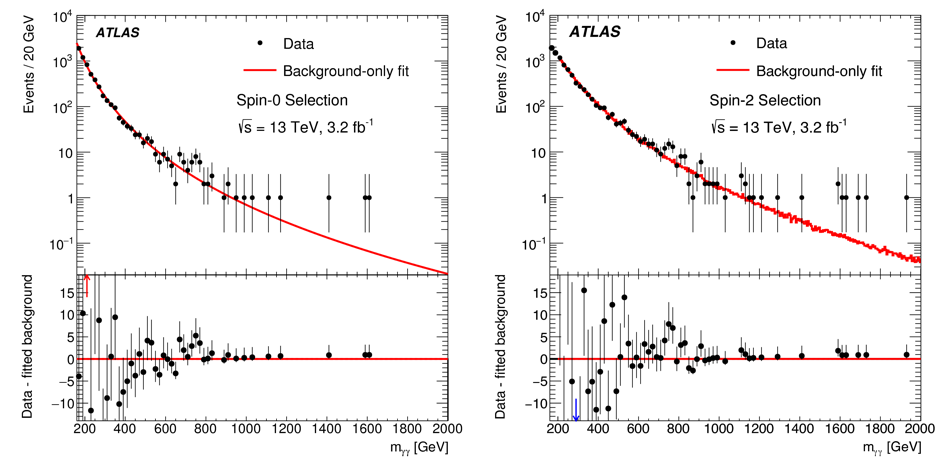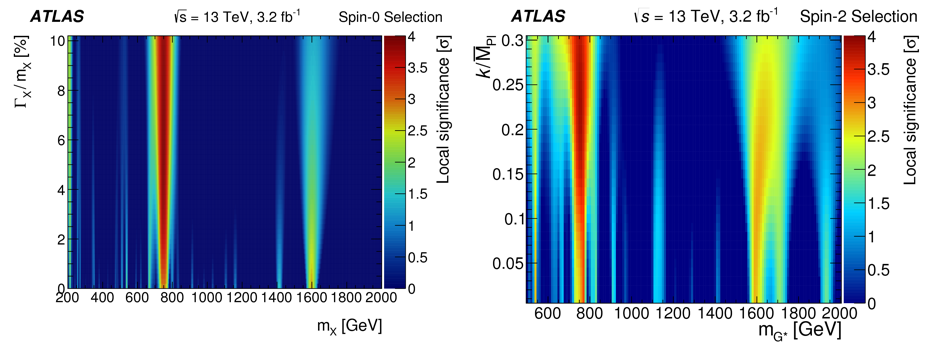Di-photons in the spotlight
17 June 2016 | By

The preliminary results presented at the Moriond 2016 conference, where a modest excess of events in the di-photon invariant mass spectrum was reported, received attention from the high-energy physics community and from the media. Following further scrutiny of the same data and refining the analysis techniques, the ATLAS collaboration has now finalised the analysis and has summarised the results in a paper submitted to the Journal of High-Energy Physics. After further cross-checks, ATLAS has confirmed the presence of a moderate excess of events in the di-photon invariant mass spectrum around 750 GeV.
The search looks for new particles predicted by some models of physics beyond the Standard Model that could decay to a pair of photons – the so called “di-photon channel”. From all the collisions produced in the ATLAS detector, only those containing two highly energetic and isolated photons are therefore considered. As the Standard Model processes producing this final state are well known and measured, they form a smooth background over which anomalies associated to new phenomena can be observed. A new particle, if generated in the collisions, would manifest itself as a localised excess of events in the di-photon invariant mass spectrum.
The ATLAS collaboration has used two benchmark models to interpret the result: one targets a Higgs-like scalar particle, expected to decay into two photons mainly in the central region of the detector (the “spin-0” selection); the second targets a graviton-like particle (the “spin-2” selection), which would often have at least one photon in the forward region of the detector. The mγγ distribution for each selection using the full 2015 dataset is shown in Figure 1. A modest excess of events for both the spin-0 and spin-2 selection at mγγ ≈ 750 GeV is visible.
The significance of this deviation is quantified to 3.9 σ for the spin-0 selection and 3.8 σ for the spin-2 selection. These values are still quite far from the threshold needed to declare a discovery.
In order to quantify whether the observed anomaly is significant, one has to take into account that the production of two photons is a stochastic process and that the number of events produced in a given mass by known Standard Model processes suffers from statistical fluctuations. One therefore has to quantify the probability that the observed excess could be explained in terms of a positive fluctuation of a known Standard Model process. A discovery is conventionally declared when this probability is extremely small, five standard-deviation away from the average expectation (the famous 5 σ level).
The compatibility of the observation with a background-only hypothesis is shown in Figure 2 for both the spin-0 and spin-2 searches. The largest discrepancy is observed when assuming the presence of a new particle with a mass of about 750 GeV and a width of about 6% to 8%, depending on the selection. The significance of this deviation is quantified to 3.9 σ for the spin-0 selection and 3.8 σ for the spin-2 selection. These values are still quite far from the threshold needed to declare a discovery.

Moreover, these probability values do not completely address the question of whether a new phenomenon has been observed. When a search is performed over a wide range of a hypothetical particle parameters (in this case, the mass and width of the new particle) one has to account for the increased probability of observing a fluctuation in the full search parameter space. The local significance is therefore converted into a global significance accounting for the size of the search range. The excess in the ATLAS data has a global significance of about 2.1 σ for both signal hypotheses and selections.
The compatibility of the new results with the data collected in 2012 was assessed for both selections and signal hypotheses. The 2012 data are compatible with the hypothesis of the production of a new spin-0 particle with a mass near 750 GeV in the 2015 data; while the 2012 disfavours the hypothesis that the modest excess observed in the 2015 data is due to a new spin-2 particle.
Overall, the picture remains far from clear. The ATLAS collaboration has kept the scientific community up-to-date, releasing information as soon as it became available. We now eagerly anticipate analysing 2016 data to shed further light on the origin of the excess.
Links:
-
Search for resonances in diphoton events with the ATLAS detector at s√=13 TeV (ATLAS-CONF-2016-018): https://cds.cern.ch/record/2141568
-
Search for resonances in diphoton events at s√=13 TeV with the ATLAS detector (arXiv:1606.03833): http://arxiv.org/abs/1606.03833



